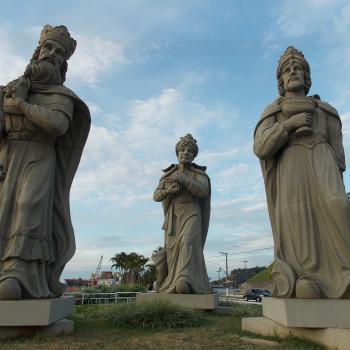If our first contemporary approach to Trinitarian spirituality led to an essential discontinuity between God’s actions and God’s being, this second modern approach does the exact opposite. That is, it conflates God’s action and God’s being, it collapses them into the same thing.
But wait, isn’t that what we wanted in our last post? Some recognition that God’s actions said something true and essential about God’s being?
Yes, that’s exactly what we need. And this seems to provide just that. As Anatolios writes, “The Christian account of divine revelation and of divine ‘faithfulness’ posits a correspondence between who God is and how God presents himself to the world.” A correspondence—a real connection. Without it we’re left with the God behind the curtain, and that sounds, well, a little Wizard of Ozish to me.
What we want to understand is both God’s work and God’s own being, and the relationship between them. There are, of course, two theological terms for these perspectives. When we talk about God’s work, we are talking about an “economic” view of the Trinity. If you can leave aside such things as GDPs, unemployment rates, and import-export ratios—things we might associate with the word economy—and instead focus on the meaning of economy as function, or organization and operation, you’ll come closer to what the theologians are talking about. So discussing the “economic Trinity” is to think about salvation history, the actions of God in the world.
The second term also has multiple meanings, and we need to zero in on just one for our purposes. This is the term “immanent.” Usually when we’re talking about God and we use the word immanent, we’re referring to God’s nearness, his presence with us—in contrast to God’s transcendence, which refers to his otherness. But in this conversation, the use of the word immanent simply means “essential” or, in a philosophical usage, ontological (in his being).
Anatolios points out that when we conflate, or collapse, an “economic” view of the Trinity with an “immanent” view of the Trinity, we are making a direct correlation of the actions of God in salvation history with the features of God within himself. The problem with this is that it equates our experience with God’s identity. If Modern Approach #1 said, well, our experience is all we’re going to get, Modern Approach #2 says that our experience is all there is to get. Either way, our encounters with God are the defining element.
(Another academic aside: Anatolios names the German Catholic theologian, Karl Rahner, as the primary promoter of this perspective.)
Anatolios also points out one major incongruence between what the Church has always believed about the divinity of the Triune Persons and the belief that the economic Trinity is the sum total of the immanent Trinity: the incarnate Son was subordinate to the Father in his incarnation and self-abasement, but within the Trinity, we believe that the Son is God, fully divine. You see, if we collapse our experience of God with the essence, or inner reality of God, we have the problem of an unequal status within the divinity. We aren’t going to really suggest, are we, that the Son is God, but just a little less God than the Father? That would take us down some very dangerous paths. (One such path is called Gnosticism, but we’ll deal with that when Anatolios brings us there.)
Some of you might recognize another version of this Modern Approach #2 in the popular expression of worship that names God the Creator, Redeemer, Sustainer (or Sanctifier), but basically thinking of these in Trinitarian terms. (Some use these terms to avoid masculine language, but I’m not going to go there…) That is, when we use these titles, we are often associating the Father with the Creator, the Son with the Redeemer, and the Spirit with the Sustainer. And of course, at one level, this is very appropriate. The Father does create; the Son does redeem; the Spirit does sustain.
But scripture is very clear that the Father sent the Son to save us and is therefore our Redeemer; that all that is, was created by the Son; and that the Spirit was at work in creation and in the life of Christ. To parse out God’s actions among the Three—the Father does this kind of work, the Son does another kind of work, and the Spirit fills in the gaps—is to conflate the economic Trinity with the immanent Trinity and define them by tasks. (And even if we like our work very much, we each know that the “me” inside is far more complex than my job title.) While we know that the human experience of God’s creative, redemptive, and sanctifying activity is a true revelation of who God is, the depth and breadth and magnificence of God’s being cannot be measured by these activities alone. To conflate the two is to “manage” our understanding of God, and diminish his greatness.
And, after all this, that is indeed what we are after, is it not? To “see” the greatness of God, to behold his wonder and his majesty, to worship him in spirit and in truth?
So, we turn from the trajectory of discontinuity (a spiritual shoulder shrug about who God really is) and from the trajectory of conflation (a ‘what-you-see-is-what-you-get’ approach), and next up we’ll look at one more way of “managing” Trinitarian language, one we’re all too familiar with. This time, even if Anatolios names some theologians associated with Modern Approach #3, you’ll be able to supply some of your own—probably your 3rd grade Sunday school teacher…
___________________________
Note to Reader: This series on Trinitarian Spirituality explores the history and spirituality behind the shaping of the Nicene Creed using Khaled Anatolios’ Retrieving Nicaea: The Development and Meaning of Trinitarian Doctrine (Grand Rapids, MI: Baker Academic, 2011) as guide and inspiration. It’s best to begin at the beginning: An Introduction.













